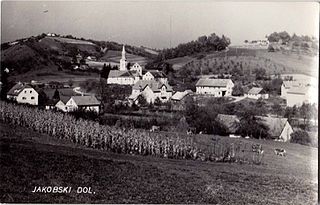
Dolnja Težka Voda is a settlement south of Novo Mesto in southeastern Slovenia. It lies on the main road from Novo Mesto to Metlika. The entire area is part of the traditional region of Lower Carniola and is now included in the Southeast Slovenia Statistical Region.

Dolnja Košana is a village west of Pivka in the Inner Carniola region of Slovenia.

Dolnja Bitnja is a small settlement northwest of Ilirska Bistrica in the Inner Carniola region of Slovenia.

Dolnja Prekopa is a settlement in the Municipality of Kostanjevica na Krki in eastern Slovenia. The area was traditionally part of Lower Carniola. It is now included in the Lower Sava Statistical Region.

Dolnja Lokvica is a settlement northwest of the town of Metlika in the White Carniola area of southeastern Slovenia. The area is part of the traditional region of Lower Carniola and is now included in the Southeast Slovenia Statistical Region.

Dolnja Paka is a small settlement west of the town of Črnomelj in the White Carniola area of southeastern Slovenia. The area is part of the traditional region of Lower Carniola and is now included in the Southeast Slovenia Statistical Region.

Dolnja Briga is a settlement in the Municipality of Kočevje in southern Slovenia. The area is part of the traditional region of Lower Carniola and is now included in the Southeast Slovenia Statistical Region.

Dragučova is a settlement in the Municipality of Pesnica in northeastern Slovenia. It lies in the hills northeast of Maribor on the edge of the Pesnica Valley. The area was part of the traditional region of Styria. It is now included in the Drava Statistical Region.

Gačnik is a settlement in the Municipality of Pesnica in northeastern Slovenia. It lies in the western part of the Slovene Hills in the valley of Gačnik Creek, a minor tributary of the Pesnica River. The area was part of the traditional region of Styria. It is now included in the Drava Statistical Region.

Kušernik is a small settlement in the Municipality of Pesnica in northeastern Slovenia. It lies in the Slovene Hills, part of the traditional region of Styria. The municipality is now included in the Drava Statistical Region.

Mali Dol is a small settlement in the Slovene Hills in northeastern Slovenia. It lies in the Municipality of Pesnica, part of the traditional region of Styria. The municipality is now included in the Drava Statistical Region.

Pesniški Dvor is a settlement in the Municipality of Pesnica in northeastern Slovenia. It lies in the Pesnica Valley in the traditional region of Styria. The entire municipality is now included in the Drava Statistical Region.

Počenik is a settlement in the Municipality of Pesnica in northeastern Slovenia. It lies in the Slovene Hills and was traditionally part of the Styria region. The municipality is now included in the Drava Statistical Region.

Ročica is a settlement in the Slovene Hills in northeastern Slovenia. It lies in the Municipality of Pesnica. The area was part of the traditional region of Styria. The entire Municipality of Pesnica is now included in the Drava Statistical Region.

Spodnji Jakobski Dol is a settlement in the Municipality of Pesnica in northeastern Slovenia. It lies in the Slovene Hills, part of the traditional region of Styria. The municipality is now included in the Drava Statistical Region.

Vosek is a settlement in the Municipality of Pesnica in northeastern Slovenia. It lies on the left bank of the Pesnica River. The area was traditionally part of Styria. The municipality is now included in the Drava Statistical Region. Jarenina Creek empties into Lake Pernica in the northeastern part of the settlement.

Vukovje is a settlement in the Municipality of Pesnica in northeastern Slovenia. It lies north and east of the Pernica Reservoir in the Slovene Hills. The area was traditionally part of Styria. The municipality is now included in the Drava Statistical Region.

Vukovski Dol is a settlement in the Slovene Hills in northeastern Slovenia. It lies in the Municipality of Pesnica, part of the traditional region of Styria. The municipality is now included in the Drava Statistical Region.

Dolnja Topla Reber is a remote abandoned settlement in the Municipality of Kočevje in southern Slovenia. The area is part of the traditional region of Lower Carniola and is now included in the Southeast Slovenia Statistical Region. Its territory is now part of the village of Topla Reber.
Mladen Kranjc was a Croatian football player, who played as a forward. Dubbed as the črni biser, Kranjc spent the majority of his football career playing for the Slovenian club Maribor, having spent there a total of 12 seasons during the 1960s and 1970s. He is regarded as one of the best players in the history of the club, and was the best goalscorer for the team in each of its five seasons spent in the Yugoslav top division, having scored a total of 54 league goals. His success eventually led to his transfer to one of the top Yugoslav clubs, Dinamo Zagreb. Kranjc has made a total of 311 appearances for Maribor, scoring 104 goals in the process. He died at the age of 43, after being involved in a motorcycle accident in Dolnja Počehova.








